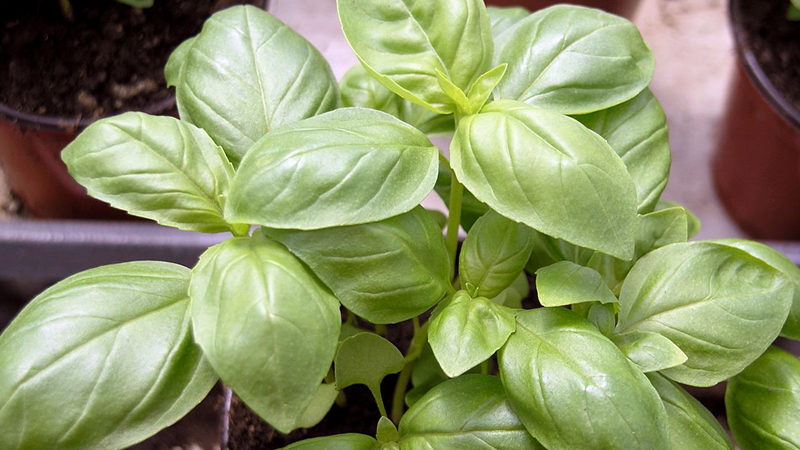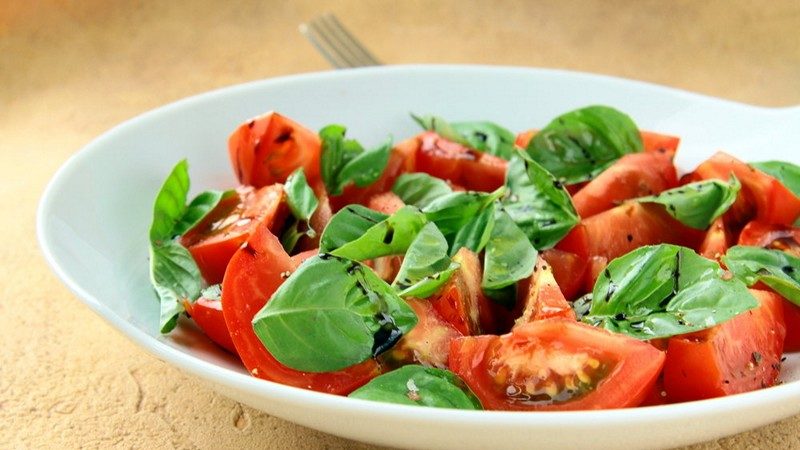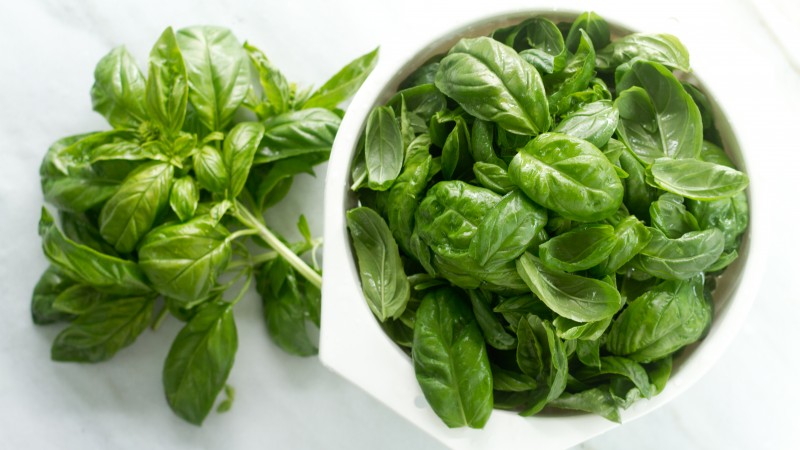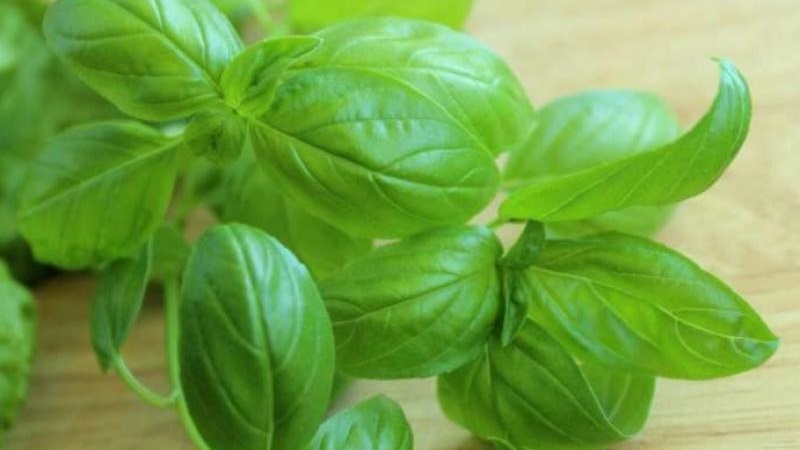Lemon basil: description, cultivation, application
Lemon basil is a hybrid of aromatic and American basil, bred by breeders specifically for use in cooking. In this article, we will tell you in detail about the most popular recipes using this spice, the beneficial properties of lemon basil and the features of its cultivation at home.
The content of the article
Description of lemon basil

Lemon basil is an annual herb of the Lamiaceae family with a straight, branched stem reaching a height of 30-40 cm, and a moderately developed, compact root system, which is a single thin white root with multiple branches.
The leaves are small, light green, oblong-oval with sharp tips and jagged edges, covered with short hairs and characterized by a pronounced lemon taste and aroma, in which notes of lemon balm and camphor are felt.
During flowering, which lasts 14-45 days, double-lipped white or pale yellow flowers appear in the axils of the apical leaves. After that, a fruit is formed on the plant, consisting of 4 nuts with small brown-brown seeds.
Seeds remain viable for 4-5 years. The yield of lemon basil is 200-300 g of leaf mass from a bush.
Useful properties and contraindications
100 g of lemon basil contains:
- water - 91 g;
- carbohydrates - 4 g;
- proteins - 3.7 g;
- fats - 0.3 g;
- unsaturated fatty acids - 0.04 g;
- dietary fiber - 0.6 g;
- sodium - 4 mg;
- potassium - 278 mg;
- calcium - 16 mg;
- phosphorus - 54 mg;
- manganese - 0.89 mg;
- iron - 3.4 mg;
- selenium - 0.3 mg;
- copper - 237 mcg;
- vitamin B1 - 0.03 mg;
- vitamin B2 - 0.076 mg;
- vitamin B9 - 76 mcg;
- vitamin C - 17 mg;
- vitamin E - 0.7 mg;
- vitamin K - 414 mcg;
- vitamin PP - 0.9 mg;
- vitamin A - 265 mcg;
- vitamin B5 - 0.3 mg.
Basil with lemon aroma is useful for colds and flu, helps to normalize the cardiovascular system, stimulates the gastrointestinal tract and speeds up metabolism, has a tonic effect, lowers blood cholesterol levels, and strengthens the immune system.
The plant is able to relieve muscle spasms, remove toxins, and strengthen cartilage tissue. Consuming lemon basil stimulates collagen production, which has a beneficial effect on skin elasticity and firmness.
Important! Basil's main disadvantage is its ability to accumulate mercury.
Except in cases of individual intolerance, basil should not be used for:
- hypotension;
- blood clotting disorders;
- diabetes mellitus;
- cardiovascular diseases;
- fever.
Uses of lemon basil
Lemon basil is used fresh, dried and canned. It gives dishes an unusual aroma and sets off the taste of the food.
Due to its lemon scent, basil leaves are used to create perfume compositions and as a flavoring agent for wines and liqueurs.
The plant is used in cosmetology, making face masks based on it, which eliminate redness and irritation, help normalize the functioning of the sebaceous glands, and help fight acne and blackheads.
Read also:
Thin-colored basil - uses and benefits
Is basil seed soaking required before planting and how to do it right
How many days after sowing basil sprouts and what should be the sprouts
Lemon Basil Recipes

Lemon basil is popular in cooking. It is most often added to salads, tea, sauces and tonic drinks.
Salad
With finely chopped lemon basil leaves, you can add a new flavor to the famous Caesar salad.
Ingredients:
- French baguette - 1 pc .;
- olive oil - 0.5 tbsp.;
- garlic - 1 clove;
- chicken egg - 1 pc .;
- lemon juice - 2 tbsp l .;
- anchovy paste - 1 tbsp l .;
- basil leaves - 1 tbsp.;
- parsley - 35 g;
- Romano salad - 450 g;
- Parmesan cheese - 120 g.
Sprinkle pieces of baguette with salt, pepper, sprinkle with olive oil and bake in the oven for 12-15 minutes. at a temperature of 190 ° C. In a blender, mix chopped garlic, egg, lemon juice, anchovy paste and black pepper to taste. Add olive oil and chopped herbs. In a bowl, mix lettuce leaves with dressing and cheese, garnish with croutons.
Fresh lemon basil leaves are paired with arugula, parsley, rosemary, tarragon and coriander, which is why these herbs are often the basis for vegetarian salads.
Salads based on tomatoes, cabbage, cucumbers and legumes acquire an unusual taste thanks to basil.
Basil is used to make salad dressings. To do this, clean and dry leaves are poured with vinegar and placed in a dark place for 14 days. After that, the greens are removed, finely chopped and poured into a container with olive oil.
Sauce

One of the most famous and popular pesto sauces consists of only 2 ingredients - fresh, minced basil and extra virgin olive oil. In the original recipe, a fragrant variety is used to make the sauce, but with the help of lemon you can diversify the usual taste.
A more complex recipe for the so-called red pesto. In addition to basil and olive oil, sun-dried tomatoes, garlic and nuts such as pine nuts are added to it. Add cheese, lemon juice and black pepper if you wish.
Tea

The easiest way to use basil is add its leaves to tea or make a decoction of them. In the first case, black or green tea is brewed and after 5 minutes. add a few basil leaves.
A spice-based decoction allows you to get the most of the benefits. For this, 50 g of basil is poured into 1 liter of boiling water and infused for 10-15 minutes.
Seeds for drinks
Delicious refreshing drinks are made from basil seeds. One of the popular recipes:
- French rose buds - 3 pcs.;
- stevia leaves - 2 pcs.;
- lemon - 0.5 pcs.;
- basil seeds - 1 tbsp. l.
Stevia leaves and rosebuds are poured over 0.5 liters of hot water and removed to cool. The resulting infusion is poured into basil seeds and lemon juice is added.
To make pinole from basil seeds you will need:
- honey - 25 ml;
- lime - 1 pc.;
- water - 225 ml;
- mint - 15 g;
- basil seeds - 40 g.
The seeds are soaked in 125 ml of water for 5-6 hours. Mint leaves are poured with 100 ml of hot water, honey is added to the same container, and after the water has cooled down - lime juice. The drink is ready immediately after mixing the two liquids.
Lemon Basil Varieties
There are several varieties of lemon basil. The most popular varieties are Lemonchik, Limoncello, Lemon Miracle, Lemon Aroma and Lemon Slices.

Lemon
Vegetable basil Lemon is an early ripening variety with a ripening period of 45 days. It is a medium-sized plant weighing 450-530 g with elliptical green leaves. The yield of greens when growing Lemon at home is 2.1-2.7 kg / m².
Limoncello
Medium ripening variety - greens are harvested 40-42 days after germination. The plant reaches a height of 30-40 cm, weighs 120-145 g, has medium-sized green ovoid leaves.
Lemon Miracle
An early ripening variety with a ripening period of 45-53 days. The plant is 22-26 cm high and weighs 300-350 g, yield - 2.3-2.5 kg / m².
Lemon scent
55-60 days pass between the emergence of full shoots and the harvest of leaves. The plant is a densely leafy shrub 40 cm high with large rich green leaves. Productivity - 1.6-2 kg / m².
Lemon wedges
Mid-season variety - 46-51 days pass from the emergence of seedlings to the beginning of economic suitability. A plant weighing 200-220 g with a half-raised leaf rosette. The leaves are green, ovoid, with a slightly bubbly surface and a slightly wavy edge. Productivity - 0.9-1 kg / m².
Growing lemon basil seeds at home
Lemon basil is grown not only outdoors and indoors seedling or by a seedless method, but also at home.
Tank and soil preparation
The most suitable containers for planting basil seeds are special peat tablets or pots. It is also permissible to use plastic flowerpots or boxes with drainage holes.
To grow spices, they use ready-made soil, which is purchased in a specialized store, or a self-prepared substrate from humus, peat and sand. In this case, the soil mixture is poured with a solution of potassium permanganate before use or ignited in the oven for disinfection.
Place and conditions for growth
Basil is a light-loving culture. It should grow in a place with at least 3-4 hours of daylight, ideally 7 hours.
Optimum temperature indicators are + 25… + 28 ° C during the day and + 20… + 22 ° C at night.
Reference. At an air temperature of + 12 ° C, the growth and development of the plant stops.
Planting seeds
Seeds are sown from late February to early April. Before sowing, they are soaked for 2-3 hours in a solution of potassium permanganate.
Algorithm of actions:
- Pour nutritious soil mixture into the prepared container.
- Pour water over it with the addition of mineral fertilizers.
- Spread the seeds on the surface every 5-6 cm, deepening them by 0.5-1 cm.
- Tamp the substrate slightly.
- Cover the container with glass or plastic wrap to create a greenhouse effect and maintain optimal humidity and temperature levels.
Seedling care
The film or glass is removed daily for 2-3 hours in order to provide oxygen access to the plantings and watering. The soil is moistened moderately, focusing on its condition - it should not dry out or be waterlogged. After watering, the ground is gently loosened.
The first shoots appear 7-10 days after sowing the seeds. When they reach 5 cm in height and form 2 leaves each, a pick is made: young plants are transplanted into a larger container filled with the same soil mixture with the addition of wood ash and complex mineral fertilizers, buried 1 cm.
When the seedlings get stronger and form 6-8 leaves, pinch the top of the plants - this contributes to the growth of the bush not only in height, but also in width.
Adult Lemon Basil Care
Lemon basil care is to comply with standard agrotechnical requirements: watering, weeding, fertilizing, loosening the soil and protecting plants from diseases and pests.
Watering
Watering is carried out as needed, on average - every 2 days. The main thing is not to allow waterlogging of the soil or drying out of its upper layer. For irrigation, use settled water, heated to + 28 ... + 30 ° C.
Fertilizer
Top dressing is applied twice during the growth period - at emergence and at the beginning of flowering. Potassium-phosphorus fertilizers (superphosphate - 20 g per 10 liters of water), wood ash or compost are used.
Weeding and loosening
After each watering, the soil is loosened to eliminate the possibility of acidification and to improve the access of oxygen, moisture and nutrients to the plant roots.
If weeds appear, weeding is carried out. In the open field, the procedure is required on average every 5 days.
Reference. In order for the basil to branch better, fresh flower stalks are gently broken out.
Prevention of diseases and pests
Among diseases and pests, the danger to lemon basil is:
- fusarium;
- gray rot;
- blackleg;
- aphid;
- field bug.
Insects suck sap from leaves and shoots, and in case of disease, the roots and leaves of plants rot and gradually dry out.
To prevent diseases and pest attacks, the rules of crop rotation are observed and weeding and loosening are regularly carried out. When the first signs of disease appear, the plants are treated with an infusion of onion peel or fungicides "Abiga-Peak", "Baktofit", "Vectra", "Gamair", "Quadris", "Mikosan", "Oksikhom", "Planriz", "Raek", "Strobi", "Trichodermin", "Fitolavin", "Horus".
Conclusion
Lemon basil is a unique plant with a rich chemical composition, which is used not only in cooking, but also in cosmetology. This basil does not have any special requirements for cultivation and care, so even novice gardeners get a rich harvest of greens.